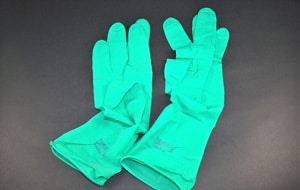Latex gloves have various uses in different industries, such as medical or dental care. Yet, they aren’t a suitable choice for all people. Someone can be allergic to their material. Hence, you should consider using alternatives to latex gloves.
The latex gloves substitutes include 5 options. They are disposable nitrile gloves, vinyl gloves, polyethylene gloves, polymer gloves, and neoprene gloves. These are workable in various fields and can help reduce or even prevent latex-allergy symptoms.
Table of Contents
List of 5 Latex Gloves Alternatives
More and more people have reacted to latex lately. But what can you use instead of gloves? To deal with latex gloves’ disadvantages, you can use replacement for latex gloves: nitrile gloves, vinyl gloves, polyethylene gloves, polymer gloves, and neoprene gloves.
1. Nitrile Gloves
Nitrile gloves are marked medical grade. They are made from nitrile butadiene rubber, which is a kind of synthetic material. These non latex rubber gloves are powder-free and less likely to trigger allergic symptoms.
They are the most common latex glove alternative for latex-allergic people. Their thickness allows you to work with various substances, including oil, petroleum, weak acids, and more. They’re also the most common choice to dye hair.
Nitrile gloves are considered hypoallergenic gloves. To put things into perspective, less than 1% of the population has allergic symptoms when exposed to the material.
As the material is relatively resistant to punctures and tears, gloves made from it can last quite a long time. So it’s a good idea to buy them in bulk to save your budget.
However, these aren’t an eco friendly alternative. The material takes up to 2 centuries to fully biodegrade in soil.
2. Vinyl Gloves
Vinyl gloves are made from polyvinyl chloride (PVC)—this material is classified as plastic and is free of latex. The feature that makes this alternative to nitrile gloves stand out is its reasonable price.
However, this alternative to latex and nitrile gloves is not very durable—it doesn’t take much to puncture a hole in the material. The gloves’ poor elasticity and low resistance against harmful substances make them unfit for a high-infection environment.
Hence, you should wear vinyl gloves in short-term and low-risk tasks, such as food preparation. Don’t wear them for longer than 2 hours, especially if you’re handling potentially harmful chemicals, such as hair dyes.
Note that vinyl gloves can still cause dermatitis and allergy in certain people, although it’s highly unlikely. What’s more worthy of concern is that both the production and decomposition of vinyl gloves release toxic substances into the environment.
Related: Detailed comparisons between vinyl vs nitrile gloves.
3. Polyethylene Gloves
Polyethylene gloves are produced from polyethylene resin. The 2 most popular poly gloves are low-density (LDPE) and high-density gloves (HDPE), with the former being softer than the latter.
Regardless of the type, polyethylene gloves are thin, featherweight, and budget-friendly options. These transparent gloves are also flexible and hard to damage. In addition, they are latex-free and powder-free gloves, so you don’t need to worry about allergens.
Another advantage of these gloves is that they are environmentally friendly. You can recycle and reuse them. The production doesn’t release harmful substances to the environment either.
Wearing poly gloves protects you from contaminants and bacteria. You can use LDPE in food processing and hairdressing. The HDPE is more rigid, so you can use it in petroleum and department stores. However, neither is suitable for medical purposes.
4. Polymer Gloves
Polymer gloves are divided into 2 categories: entirely polymer gloves and coated-polymer gloves. If you want to avoid latex allergies, use the coated ones, which feature a layer of polymer on the inside of latex gloves.
This layer helps to separate your skin from the latex. Hence, you won’t come into contact with the allergenic material. Plus, the polymer coat makes the interior finish less tacky and smoother to wear.
You can wear polymer gloves when working with waste. The gunk and slime are hard to stick to your gloves. In medical fields, the coats used are silicone polymer, polymer blends, and more. You aren’t able to smell any odor in these coats.
5. Neoprene Gloves
Another ideal nitrile glove alternative is neoprene gloves, which are made from chloroprene—a type of synthetic rubber. This latex-free substitute is ideal for working with low-risk and short-term tasks.
Thanks to their high elasticity, neoprene gloves can fit your hands snugly. The material also boasts excellent resistance to punctures and tears. And as it’s impervious to most toxins and organic acids, neoprene is recommended for mechanic jobs, pesticide sprayer operators, or lab workers.
However, neoprene gloves are vulnerable to strong acids, ketones, and hydrocarbons. Their high cost can also put some people off.
Things to Consider Before Choosing Latex Gloves
Latex is constructed from proteins and natural compounds harvested from rubber trees. Gloves made from this biodegradable material are used in numerous tasks, such as mechanics, forensics, and more. The FDA approves of using them in healthcare as latex gloves dentists, and food service.
While buying latex gloves may seem as simple as it gets, there are a few things you need to keep in mind to avoid purchasing unsuitable ones.
1. Intended Workplace
You need to determine when and where you use latex gloves. The gloves should provide you with good protection against toxic substances. Also, they need to fit snugly without cutting off your circulation so that you can work comfortably.
2. FDA Approves Or Not
FDA means the Food and Drug Administration. The department is responsible for protecting your safety, security, and more. To ensure latex gloves are safe to use, you have to check the legitimacy of the gloves boxes.
Many manufacturers earn money by producing low-quality latex gloves without FDA’s approval. This threatens your health directly. You should check the detailed information on the package. Next, check the barcode. If the information is clear, you can wear them.
You can also consider the price. If it is too low compared to the average pricing on the market, the products are likely fake.
3. Brand
Not all gloves brands share common features. They can adjust powder content when producing latex gloves. Some brands offer you powder-free, low-protein latex gloves. Meanwhile, others give you powdered gloves.
The materials they use also decide on the gloves’ quality. You should search and compare each brand to find the good ones.
FAQs
What are latex gloves used for?
Wearing latex gloves is a protective barrier when you work in chemical environments. Specifically, they will safeguard you from skin irritants, harmful or unsanitary substances, and bacteria.
You can wear latex gloves in various industries: food preparation, medical, auto technicians, cosmetics, hairdressing, and forensics.
What’s the problem with latex gloves?
Not all people can wear latex gloves due to latex allergic reactions. This happens when your skin contacts certain proteins in these gloves. The exact amount of proteins that can cause reactions hasn’t been determined yet.
Latex allergies can appear within several minutes or hours after you wear gloves. The symptoms range from mild to serious. You may experience skin redness, itching, hives, or rash. Some sensitive people can have runny noses, scratchy throats, sneezing, and breathlessness.
While latex allergy isn’t life-threatening, you should consider opting for alternatives to protect yourself.
Conclusion
Overall, there are 5 common alternatives to latex gloves you can choose from. Nitrile is the most popular option. Vinyl, polyethylene, polymer, and neoprene gloves are excellent substitutes.
You can purchase these replacements from any store. Make sure the products are durable and suitable for your intended use. Remember to list down the features you need in gloves to find the right ones quickly.

This is Edward Manning, the editor in chief of Construction Informer. Quite a bit of my time is spent researching the market and interviewing experts in the field so that I can give you reliable information.







